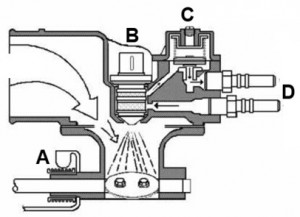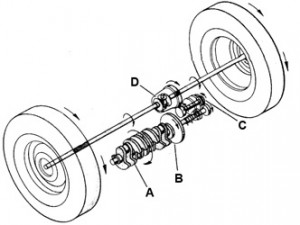Try our free ASVAB Automotive Information Practice Test. The automotive section has 11 questions and you are given 7 minutes in which to answer them. Topics covered include the engine, cooling system, fuel system, lubrication system, ignition system, electrical system, brake system, exhaust system, and suspension. If you don’t have a lot of background knowledge about cars then you will want to buy a study guide.
Congratulations - you have completed .
You scored %%SCORE%% out of %%TOTAL%%.
Your performance has been rated as %%RATING%%
Your answers are highlighted below.
Question 1 |
Which system is required to start an automobile?
Electrical | |
Lubrication | |
Exhaust | |
Drive train |
Question 1 Explanation:
The correct answer is (A). A car’s electrical system controls lighting, starting, charging, and accessories.
Question 2 |
Which of the following is NOT part of an internal combustion engine?
piston ring | |
connecting rod | |
clutch | |
cylinder head |
Question 2 Explanation:
The correct answer is (C). The clutch is part of the drive train system.
Question 3 |
In a four-stroke engine, which of the following is NOT one of the four strokes?
Intake | |
Compression | |
Out-take | |
Exhaust |
Question 3 Explanation:
The correct answer is (C). Each stroke is the movement of the piston from one end of the cylinder to the other. The four strokes are called Intake, Compression, Power, and Exhaust.
Question 4 |
In the diagram below, what is the location of the fuel pressure regulator?

A | |
B | |
C | |
D |
Question 4 Explanation:
The correct answer is (C). As pictured above, the fuel pressure regulator regulates pressure in the fuel rail according to intake manifold vacuum.
Question 5 |
Which part of the fuel system sprays a fuel and air mixture into the engine's combustion chamber?
fuel pump | |
fuel injector | |
fuel filter | |
fuel pressure regulator |
Question 5 Explanation:
The correct answer is (B). Fuel injectors atomize the fuel by pumping it through a small nozzle under high pressure. Atomizing the fuel is the process of breaking it into a fine misted spray.
Question 6 |
What part of a car's exhaust system is responsible for turning the toxic components of engine exhaust into less toxic compounds?
cylinder head | |
exhaust manifold | |
muffler | |
catalytic converter |
Question 6 Explanation:
The correct answer is (D). After being collected in the exhaust manifold, exhaust gases are then sent to the catalytic converter where toxic pollutants are converted into less toxic compounds by catalyzing a redox reaction.
Question 7 |
Which of the following is the location of the differential on a drive axle?

A | |
B | |
C | |
D |
Question 7 Explanation:
The correct answer is (D). A differential allows cars to rotate at different speeds as the car goes around a corner. It helps the drive axle split the power between the two drive wheels.
Question 8 |
The brake caliper is an assembly that houses the
drum brakes | |
brake shoes | |
brake boosters | |
brake pads and pistons |
Question 8 Explanation:
The correct answer is (D). Disc brakes slow the rotation of the wheels using friction, which is created by pushing the brake pads against the brake discs with a set of calipers.
Question 9 |
The part of the tire that grips the rim of the wheel is the
bead | |
sidewall | |
shoulder | |
ply |
Question 9 Explanation:
The correct answer is (A). The bead is the inner edge of a tire. It is normally made with high-strength rubber and is reinforced with steel wire.
Question 10 |
If one complete revolution of the steering wheel causes the wheels to turn 20 degrees, what is the steering ratio?
12:1 | |
15:1 | |
18:1 | |
20:1 |
Question 10 Explanation:
The correct answer is (C). A complete revolution of the steering wheel is 360 degrees. Thus, the steering ratio is 360:20 which reduces to 18:1 (360/20=18).
Question 11 |
An internal combustion engine in which the cylinders are aligned in two banks, which are at an angle to each other, is known as a
inline engine | |
rotary engine | |
V-engine | |
boxer engine |
Question 11 Explanation:
The correct answer is (C). The angle of the two cylinder banks makes a "V" shape.
Once you are finished, click the button below. Any items you have not completed will be marked incorrect.
There are 11 questions to complete.
|
List |
